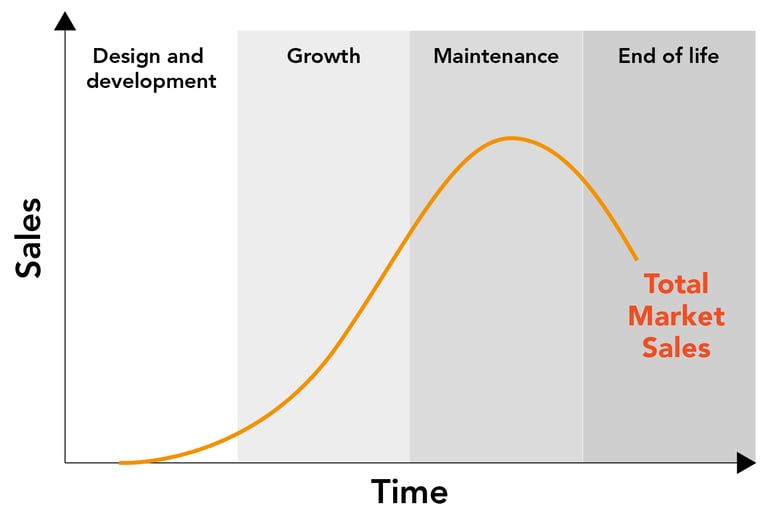By Micaela Wochner
For product manufacturers in the medical and diagnostics equipment industry, developing an effective product lifecycle management process is no longer a “nice to have” but a “must have”. From managing the cost of product ownership to transitioning product updates without disruptions in regulatory compliance, a long-term holistic view of product lifecycle management can help you maintain customer loyalty and build trust in new product development.

Effective product lifecycle management starts with designing medical and diagnostic equipment for a long and profitable lifespan.
Simply put, product lifecycle management is a key factor in determining which products have long-term success and which fail to achieve their potential. Whether your product development process involves OEM partners or a select few component suppliers, optimizing your product lifecycle management has an impact on your bottom line.
What is product lifecycle management?
Product lifecycle management is “an integrated, information-driven approach to all states of a product’s life from its design inception, through its manufacture, deployment and maintenance, and culminating in its removal from service and final disposal.” ¹
 Lifecycle management (LCM) is ongoing as a product moves through the typical stages of its lifecycle: design and development, growth, maintenance, and end of life. This involves the design, the manufacturing of the product and its sale and delivery.
Lifecycle management (LCM) is ongoing as a product moves through the typical stages of its lifecycle: design and development, growth, maintenance, and end of life. This involves the design, the manufacturing of the product and its sale and delivery.Effective product LCM brings together the many suppliers, departments and employees involved with a product's design and production in order to streamline activities. The ultimate goal is to deliver a product that outperforms its competitors, is highly profitable, and lasts as long as market desire and technology lifespan permit.
Reinventing product lifecycle management
Today’s international business environment means that companies need to manage products on a global basis. Manufacturers are collaborating with many different partners in product planning and development ranging from innovative design and OEM suppliers to efficiency-building supply-chain initiatives to manufacturing outsourcing. Companies are also developing products that can be customized for different markets and customer target audiences and more easily integrated with existing systems.
This growth in collaboration requires companies to gain tighter control of their production runs, while also incorporating more data and feedback into their development processes. Product lifecycle management aims to provide timely and reliable information flow between partners to ensure all functional groups have the correct information to deliver a successful product that achieves long-term life span and product evolution goals.
The growth of this methodology as a standard operating practice is escalating, especially as companies look for ways to manage increasing regulatory compliance challenges.
Indeed, the global product lifecycle management (PLM) software market is projected to increase significantly in the next five years from the market size of $18.57 billion in 2018 to over $26.33 billion by 2023. The global PLM market is expected to grow at a compound annual growth rate (CAGR) of 7.2% from 2018–2023. ²
What does lifecycle management achieve?
The overarching goal of product lifecycle management is to expand the profitable period of your product while maintaining customer loyalty as you introduce new products or retire old ones. Some key reasons to use LCM include:
1. Risk mitigation and error reduction.
You want to make sure your product remains compliant, safe, dependable and continues to offer reproducible results that stay well within regulatory standards. You don’t want any FDA scares as you roll out new products, functions or versions. LCM helps you make sure updates or changes maintain all compliance and safety standards so your customers remain confident in your products.
2. Keep the product continuously attractive.
LCM means better planning for future regulatory and technology changes, product enhancements, geographic expansion, customer needs and service requirements. Keeping your suppliers and OEM partners connected helps you manage market updates more effectively by understanding the broader market implications.
3. Design products that are easier to service.
Collaborating on product design and development can help keep the future cost of ownership of your product under control. By incorporating the right components, you’ll be able to deliver a reliable product with fewer planned and unplanned service interventions, reducing your service costs, enhancing your brand image and growing customer satisfaction.
4. Adhere to regulatory requirements.
For example, new European IVD Regulations have more explicit and stringent requirements that extend across the entire product lifecycle, including post-market activities around monitoring/surveillance, corrective action and reporting.
What should you consider when incorporating lifecycle management?
Making LCM work for your company may mean adopting new processes and partnerships that allow for a collaborative approach and information exchange. Some guidelines to consider:
- “Di-silo” information. Strive to give all business groups access to information such as customer complaints, product failures, points of integration, or logistical hurdles.
- Incorporate data analysis.Gather and evaluate data on product usage, supply chain availability, production hiccups, and technology changes.
- Collaborate. Work with global partners early on in the product development process to gain insights that will improve product service and life span.
- Map out a future strategy. Plan for product updates and end of life at an early phase to ensure a smooth transition. This includes planning for continued compliance, obsolescence management, product evolution and next generation of the product.
- Use expert services. Adopting data-based tools and working with experts versed in LCM will improve your results.
- Incorporate regulatory compliance. Factor in ongoing regulatory compliance needs and ensure new components or updates meet these standards.
- Consider end-user needs. As you roll out updates or new products, be sure to account for disruptions in processes, accuracy of tests, and ease of use, and offer services and information that help maintain customer trust.
By incorporating product lifecycle management into your value chain for diagnostic equipment, you may extend the life span of your products. You’ll also be able to maximize profitability, while maintaining customer satisfaction for products that stay technologically current, updated and compliant with minimal impact on your customer’s own processes when existing products are upgraded or phased out.
Improve your product lifecycle management
Download our guide to lifecycle management for IVD products. It covers key steps to consider in each stage of the lifecycle: design and development, growth, maintenance and end of life.
Partnering Services for Lifecycle Management
Learn more about how Tecan Synergence helps manage your product lifecycle from development through customer support.

References
1. Growing Emphasis on Product Lifecycle Management, August 18, 2004, SCRC SME.
2. Market Outlook: Product Lifecycle Management (PLM), 2018 – 2023, Worldwide, Quadrant Knowledge Solutions Private Limited (2018).
3. Grieves, Michael. (2003). PLM - Beyond lean manufacturing.. Manufacturing Engineering, 130, 23-23.
Keywords:
About the author

Micaela Wochner
Micaela Wochner, Head of Customer Operations, together with a team of professionals, manages all day-to-day interactions with and for our OEM partners: the right delivery, at the right time, compliant, in the right quality, and the right price in the hands of our customers. Micaela joined Tecan in 2012 as Program Manager. In 2015 she developed the Customer Operations team from the former Product Management and Program Management team thus sharpening the customer focus of Tecan Partnering. Micaela joined Tecan with 20 years experience in the Healthcare Industry in Commercial, Clinical Affairs and Project and Program Management roles.












